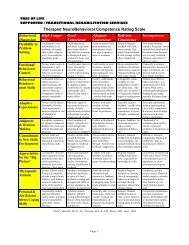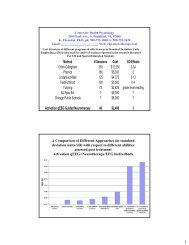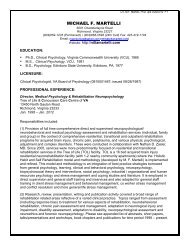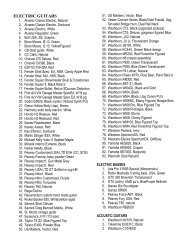Slull reacquisition after acquired brain injury - villa martelli disability ...
Slull reacquisition after acquired brain injury - villa martelli disability ...
Slull reacquisition after acquired brain injury - villa martelli disability ...
You also want an ePaper? Increase the reach of your titles
YUMPU automatically turns print PDFs into web optimized ePapers that Google loves.
126 M.E Martelli et al. /Skill <strong>reacquisition</strong> aper <strong>acquired</strong> <strong>brain</strong> injurj<br />
A.L. Pitel, H. Beaunieux, N. Lebaron, F. Joyeux, B. Des-<br />
granges and E Eustache. Two case studies in the application<br />
of errorless learning techniques in memory impaired patients<br />
with additional executive deficits, Brain Inj 10 (2006). 1099-<br />
11 10.<br />
J.W. Pope and R.S. Kern, An "errorful" learning deficit in<br />
schizophrenia? Journal of Clinical and Experimental Neu-<br />
mpsychology 28 (2006). 101-1 10.<br />
G.P. Prigatano, Psychiatric aspects of head <strong>injury</strong>: Problem<br />
areas and suggested guidelines for research, in: Neurobehav-<br />
ioral Recoveryfmm Head Injury, H.S. Levin, J. Grafman and<br />
H.M. Eisenberg, eds, Oxford University Press, New York,<br />
1987, pp. 215-231.<br />
G. Prigatano, Principles of Neuropsychological Rehabilita-<br />
tion, Oxford, New York, 1999.<br />
G.A. Riley. A.J. Brennan and T. Powell, Threat appraisal and<br />
avoidance <strong>after</strong> traumatic <strong>brain</strong> <strong>injury</strong>: why and how often are<br />
activities avoided?, Brain Injury 18 (2004). 871-888.<br />
D.C. Rim and J.C. Masters. Behavior Therapy: Techniques<br />
and Empirical Findings, (2nd ed.), Academic Press, New<br />
York, 1979.<br />
R.J. Sbordone. Cognitive rehabilitation of the traumatic <strong>brain</strong>-<br />
injured patient in the year 2000, Psychotherapy in Private<br />
Practice 8 (1990). 129-138.<br />
D. Schacter, Searching for Memo?. Basicbooks, New York,<br />
1996.<br />
M. Schmitter-Edgecombe and L. Beglinger, Acquisition of<br />
skilled visual search performance following severe closed-<br />
head <strong>injury</strong>, Journal of the International Neuropsychological<br />
Society 7 (2001). 615-630.<br />
L.E. Schutz and K. Trainor, Evaluation of cognitive rehabili-<br />
tation as a treatment paradigm, Brain Injury 21 (2007). 545-<br />
557.<br />
M.E.P. Seligman and D.M. Isaacowitz, Learned helplessness,<br />
in: Encyclopedia of Stress, G. Fink, ed., Academic Press, San<br />
Diego, 2000.<br />
M.D. Spiegler, Contemporay Behavioral Therapy, (4th ed.),<br />
Belmont, CA: Wadsworth.<br />
E.J. Squires, N.M. Hunkin and A.J. Parkin, Errorless learning<br />
of novel associations in amnesia, Neuropsychologia 35 (1997),<br />
1103-1111.<br />
E. Taub, Movement in nonhuman primates deprived of so-<br />
matosensory feedback, Exercise and Sports Science Reviews<br />
4 (1977), 335-374.<br />
E. Taub, J.E. Crago and G. Uswatte, Constraint-induced move-<br />
ment therapy: A new approach to treatment in physical reha-<br />
bilitation, Rehabilitation Psychology 43 (1998). 152-170.<br />
E. Taub, G. Uswatte and D.M. Moms, Improved motor recov-<br />
ery <strong>after</strong> stroke and massive cortical reorganization follow-<br />
ing Constraint-Induced Movement therapy, Phys Med Rehabil<br />
Clin NAm 14 (2003), S77-S91. ix.<br />
D.D. Todd, M.F. Martelli and R.L. Grayson, The Cogni-<br />
phobia Scale (C-scale), Test in the public domain, 1998.<br />
http://<strong>villa</strong><strong>martelli</strong>.com/nanposters1999.htm<br />
M. Verfaellie, L.S. Cermak, S.P. Blackford and S. Weiss,<br />
Strategic and automatic priming of semantic memory in alco-<br />
hoIic Korsakoff patients, Brain Cognition 13 (1990), 178-192.<br />
B.E. Wampold, The Great Psychotherapy Debate: Models,<br />
Methods, and Findings. Lawrence Erlbaum Associates, New<br />
Jersey, 2001.<br />
F.C. Wilson and T. Manley, Sustained attention training and<br />
errorless learning facilitates self care functioning and chronic<br />
ipsilesional neglect following severe traumatic <strong>brain</strong> <strong>injury</strong>,<br />
Neuropsychological Rehabilitation 13 (2003). 537-548.<br />
R.L. Wood, Understanding the 'miserable minority'; a<br />
diathesis-stress paradigm for post concussional syndrome,<br />
Brain Injury 18 (2004), 1135-1 153.<br />
N.D. Zasler and M.F. Martelli, Stare of the Art Reviews:<br />
Functional Disorders in Rehabilitation, Hanley and Bel-<br />
fus, Philadelphia, 2002. http://<strong>villa</strong><strong>martelli</strong>.com/STARSAbs&<br />
ChapLnks.htrn.<br />
N.D. Zasler, M.E Martelli and K. Nicholson, Chronic Pain<br />
(and Traumatic Brain Injury), in: Textbook of Traumatic<br />
Brain Injury, J.M. Silver, S.C. T.W. McAllister and Yudofsky,<br />
eds, American Psychiatric Publishing, Arlington, VA, 2005,<br />
pp. 419436.








